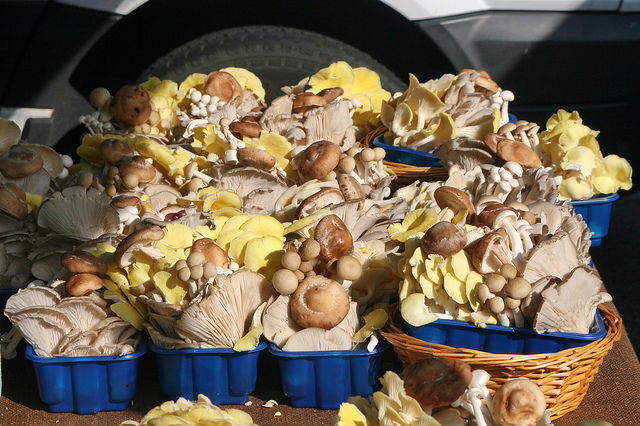There’s fungus in your food
A whole kingdom to thank for more than just mushrooms
Meghan Bartels • April 4, 2016
Unless portabellas or porcinis are on the menu, the thought of eating fungus is a little unsettling. But the surprising truth is that we’d miss some culinary delights if we turned up our noses at all fungi. Here’s where fungi are lurking on your plate.
Yeast spread
Featured fungus: Saccharomyces cervisiae
![Marmite, the English spread that uses the tagline “love it or hate it” in its advertising, is known for eliciting strong reactions, but they usually aren’t about the fungi inside. [Image credit: Alez Juorio | CC BY 2.0]](https://scienceline.org/wp-content/uploads/2016/04/2308424483_e4b2a6a72b_z.jpg)
Marmite, the English spread that uses the tagline “love it or hate it” in its advertising, is known for eliciting strong reactions, but they usually aren’t about the fungi inside. [Image credit: Alex Juorio | CC BY 2.0]
The common British spread Marmite is also processed yeast and has been described as tasting like “the flavor packet that comes with beef flavored ramen” or “salty beefy fermented soy sauce.”
Cheese
Featured fungi: Penicillium roqueforti and Penicillium camemberti
![Blue cheeses like Stilton are named for the blue fungus running through the cheese. [Image credit: Designgeist | CC BY 3.0]](https://scienceline.org/wp-content/uploads/2016/04/Quarter_Wedge_of_Quenby_Hall_Blue_Stilton®.jpg)
Blue cheeses like Stilton are named for the blue fungus running through the cheese. [Image credit: Designgeist | CC BY 3.0]
Other mold-ripened cheeses, such as Camembert, stand out for their rinds, which are actually dense fungal webs. Whether you share this information with fellow guests at the next reception you attend is your call.
Soy sauce
Featured fungus: Aspergillus oryzae
![During the production process, soy sauce is left to ferment in traditional wooden vats. [Image credit: Joi Ito | CC BY 2.0]](https://scienceline.org/wp-content/uploads/2016/04/9464330618_e6132619f7_z.jpg)
During the production process, soy sauce is left to ferment in traditional wooden vats. [Image credit: Joi Ito | CC BY 2.0]
Huitlacoche or cuitlacoche
Featured fungus: Ustilago maydis
![A fungus infects individual corn kernels, which enlarge and turn color, to create huitlacoche. [Image credit: Strobilomyces | CC BY-SA 4.0]](https://scienceline.org/wp-content/uploads/2016/04/Ustilago_maydis_Mexico_150331wa-400x326.jpg)
A fungus infects individual corn kernels, which enlarge and turn color, to create huitlacoche. [Image credit: Strobilomyces | CC BY-SA 4.0]
Huitlacoche may not look appetizing, but it’s a local delicacy, nicknamed Mexican truffle and often baked into quesadillas. In fact, farmers inject spores into growing corn ears to increase the likelihood of kernels becoming infected. Huitlacoche is less popular in the U.S., where it is still typically called corn smut as if it were a disease, although some foodies are working to improve its reputation.
Salami
Featured fungus: Penicillium nalgiovense
If you buy traditionally-made hard salami, it may be covered in a thin layer of powdery white mold — but that doesn’t mean you need to throw it out. Salami makers purposely include a safe species of mold in the meat mixture. It actually protects the meat by keeping out other molds that aren’t so kind. It also helps flavor by keeping the meat from getting too acidic and makes sure the meat dries evenly so that it doesn’t rot. Although the strain chefs add is safe to eat, the U.S. Department of Agriculture recommends you wipe the mold dusting off the outside of the salami to be on the safe side. And food safety regulations are making it harder for salami makers to use this technique, called dry-cure. It’s easier to monitor temperatures than the warning signs trained salami-makers recognize, so regulators would rather chefs cook the meat instead.At the beginning of 2015, scientists announced they had discovered a previously unknown species of fungus in salami. They named it Penicillium salami in the food’s honor. They aren’t worried about it being dangerous, but they want to do more research to see whether it’s another example of a fungus hard at work making our meals tastier.

![Traditionally made salami curing in Italy. [Image credit: Kelly Hau | CC BY 2.0]](https://scienceline.org/wp-content/uploads/2016/04/6838135175_3196fa0201_z.jpg)
3 Comments
Thank you for this website, I successfully used it for my science during lockdown. Well done .
science good, good page, good science, yes!
good, yeeeeeeeeeeeeeeeeessss gooid yeast tasty